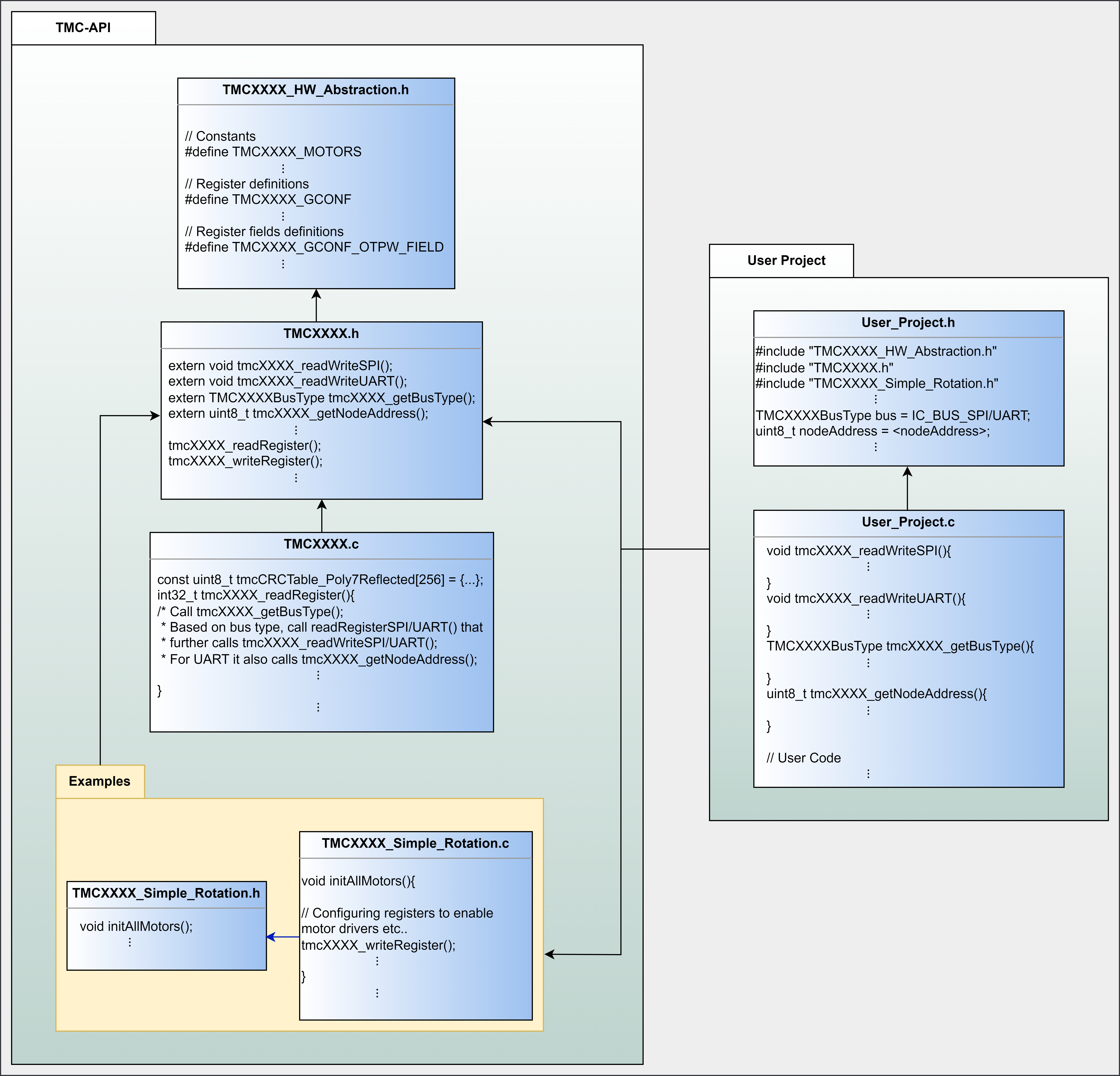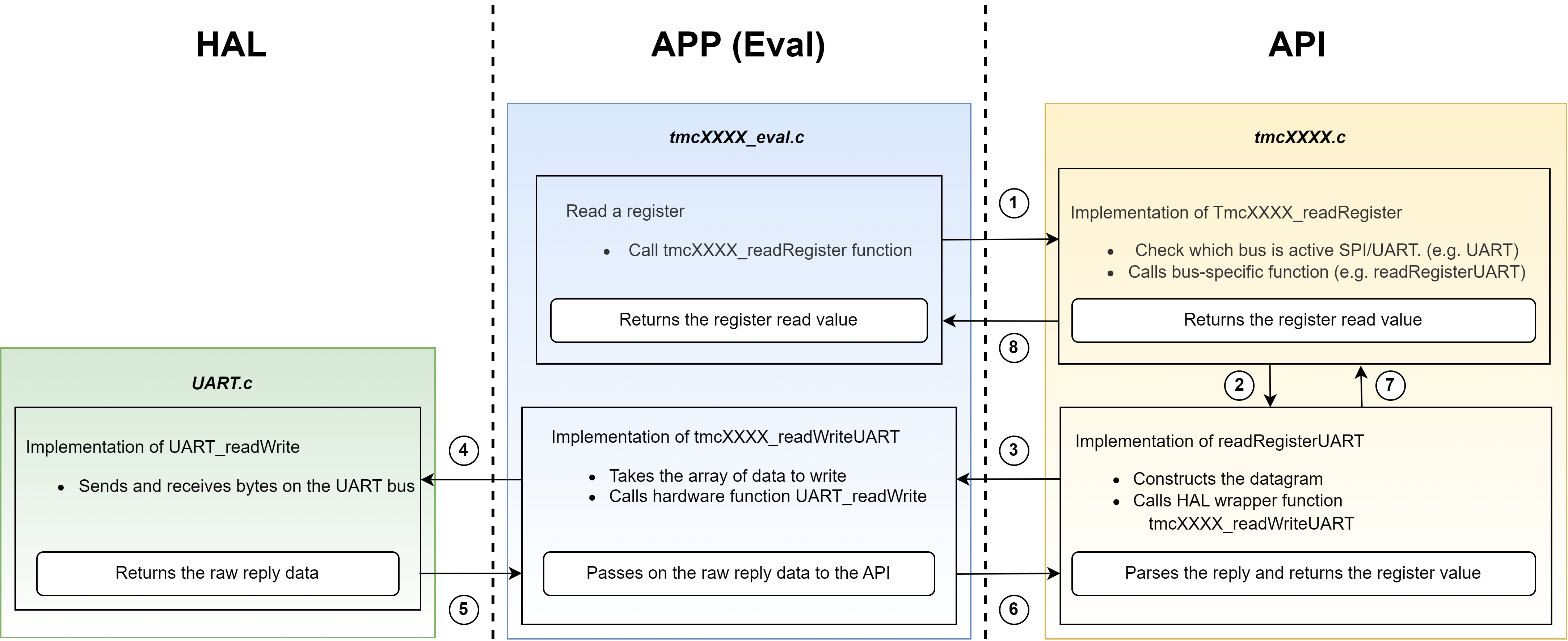To access the TMC5272's registers, the TMC-API offers two functions: tmc5272_readRegister and tmc5272_writeRegister. Each of these functions takes in an icID, which is used to identify the IC when multiple ICs are connected. This identifier is passed down to the callback functions (see How to Integrate).
- Include all the files of the TMC-API/ic/tmc/TMC5272 folder into the custom project.
- Include the TMC5272.h file in the custom source code.
- Implement the necessary callback functions (see below).
- (optional): Take a look at the Examples subfolder for ready-made examples of the TMC-API usage.
The following diagram depicts how to access the TMC5272 via UART using the TMC-API.
The description of the functions, in the above flowchart, are as follows:
- The functions tmc5272_readRegister and tmc5272_writeRegister are used to read and write the registers respectively. These functions check the current active bus and calls the bus-specific function i.e readRegisterUART or writeRegisterUART.
- These bus specific functions constructs the datagram and further calls the bus specific callback 'tmcXXXX_readWriteUART.
- This callback function further calls the hardware specific read/write function for UART and needs to be implemented externally.
To communicate with TMC5272 IC, the TMC-API library needs to know which bus (UART, SPI) it shall use. For that, the callback function 'tmc5272_getBusType()' needs to be implemented. Additionally, implement the following callback functions to access the chip via UART:
- tmc5272_readWriteUART(), which is a HAL wrapper function that provides the necessary hardware access.
- tmc5272_getNodeAddress(), that returns the node/slave address. Node address could be set in NODECONF (0x3) register and the address could be incremented as defined by AD0, AD1 and AD2. (Node address + ADx) must be less than 255. For further details please consult the datasheet of TMC5272.
The TMC5272 UART protocol uses an 8 bit CRC. For calculating this, a table-based algorithm is used. This table (tmcCRCTable_Poly7Reflected[256]) is 256 bytes big and identical across multiple different Trinamic chips (i.e. TMC2209). If multiple Trinamic chips are being used in the same project, avoiding redundant copies of this table could save memory. It is possible to substitute this CRC table with another CRC table.
The following diagram depicts how to access the TMC5272 via SPI using the TMC-API.
The description of the functions, in the above flowchart, are as follows:
- The functions tmc5272_readRegister and tmc5272_writeRegister are used to read and write the registers respectively. These functions check the current active bus and calls the bus-specific function i.e readRegisterSPI or writeRegisterSPI.
- These bus specific functions constructs the datagram and further calls the bus specific callback 'tmcXXXX_readWriteSPI.
- This callback function further calls the hardware specific read/write function for SPI and needs to be implemented externally.
To communicate with TMC5272 IC, the TMC-API library needs to know which bus (UART, SPI) it shall use. For that, the callback function 'tmc5272_getBusType()' needs to be implemented. Additionally, implement the following callback functions to access the chip via SPI:
- tmc5272_readWriteSPI(), which is a HAL wrapper function that provides the necessary hardware access. This function should also set the chip select pin CSN to low before starting the data transfer and set to high upon completion. Please refer to the datasheet of the IC for further details.
This graph illustrates the relationships between files within the TMC-API library, highlighting dependencies and identifying the files that are essential for integrating the library into the custom projects.

For a reference usage of the TMC-API, visit the TMC-Evalsystem
The TMC5272 has been reworked to the access system described above. For more infos on the status of this and other ICs, check out the migration page.

